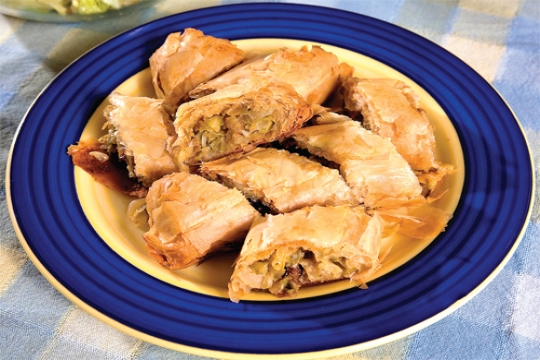This recipe is featured in Tina Wasserman's book, Entree to Judaism for Families filled with tools to help children learn to cook with confidence, with clear, step-by-step instructions for every recipe and tips for adults to make the experience safe and rewarding.
Food encased in dough is popular for Rosh HaShanah because of the visual reminders of being "sealed" in the Book of Life in the coming year. The following strudel dish, reminiscent of apple strudel (for which Hungarians are renowned) but including cabbage and caraway seeds (indigenous to Hungarian cooking) and discarding cinnamon and sugar, demonstrates the creativity of Hungarian Jewish cooks in times of scarcity.
The round, light-green vegetable we call cabbage became popular in Germany about nine hundred years ago. Because it was very easy to grow in cold climates like Northern and Eastern Europe, it was very popular in Jewish cooking, especially in the poor communities of Eastern Europe. Cooked in every way possible, cabbage was often found in soup, stews, or even pickled (sauerkraut). For festivals, cabbage was “dressed up” and stuffed or used as a filling in pastries, an alternative to costly nuts, fruit, sugar, and spices. The combination of cabbage and caraway seeds in this strudel was a classic Hungarian preparation. Cabbage was very popular in Ashkenazic communities during all the Jewish fall festivals: sealed in strudel for Rosh HaShanah, as we hope to be sealed in the Book of Life for the coming year; served during Sukkot as a fall harvest food; and, according to culinary historian Gil Marks, served during Simchat Torah because the Hebrew word for cabbage, k’ruv, sounds like the word for the cherubim on the top of the Ark that held the tablets of the Ten Commandments
- Cut the cabbage in half lengthwise, then thinly slice into shreds crosswise. Place in a large bowl, add 1⁄2 tablespoon salt to cure the cabbage, and toss. Set it aside for 15 minutes to half an hour.
- Using strong paper towels or a clean cloth towel, squeeze the water out of the cabbage and pat it dry.
- Heat a 10-inch frying pan over high heat for 20 seconds. Add 2–4 Tablespoons butter or butter/olive oil blend, allowing it to melt but not brown.
- Mix in the cabbage and stir over medium heat for 10–15 minutes until the cabbage is soft and slightly browned.
- Season to taste with salt, pepper, and caraway seeds (if using).
- Place the cabbage in a bowl to cool.
- Melt the remaining butter. Set aside.
- Remove 4 sheets of defrosted Phyllo dough (keeping the remaining sheets folded and covered by a sheet of plastic wrap that is re-covered with a damp paper towel). Spread out a thin towel, sheet of waxed paper, or plastic wrap that is as long as the dough.
- Place one sheet of Phyllo on the towel and brush it liberally with some of the melted butter. Place another sheet of dough on top of the first and brush with melted butter.
- Repeat this with the remaining 2 sheets.
- Lightly sprinkle the bread crumbs over the last sheet and then place half of the cabbage in a 2-inch-thick strip parallel to the short edge of the dough. Leave 1 inch of room on the side ends so the cabbage can be encased.
- Using the towel or plastic wrap, fold the dough tightly over the cabbage. Brush the 2 long edges of the dough with butter, then fold them in about 1 inch to encase the cabbage. Lift up the towel to help you tightly fold the roll of dough. Place the finished roll seam-side down on a parchment-lined, low-sided cookie sheet.
- Repeat the process with the other half of the dough and the filling.
- Preheat the oven to 375˚F. Brush the tops of the rolls with melted butter and lightly cut on the diagonal through a few layers of dough with a sharp knife at 1-inch intervals.
- Bake the strudels in the center of the oven for 25 minutes or until golden brown. Cut through slash marks and serve.
- To prevent Phyllo dough from cracking when handled, thaw it in its sealed box in the refrigerator for 24 hours, or alternatively thaw on the kitchen counter away from direct heat or sunlight for about 4 hours. Do not try to defrost the dough in the microwave!
- If your dough is stuck together and cannot be rolled, crumble it, toss with a stick of melted butter, and place half of it in the bottom of a 13" x 9" pan. Cover with the cabbage mixture and then with the rest of the Phyllo crumbles mixed with butter. Bake at 375˚F for about 20–25 minutes, until the Phyllo is golden. Cut into squares and serve.
- Any recipe using Phyllo dough may be frozen before baking so long as the filling is pre-cooked. Just don’t freeze raw fruits and vegetables or uncooked eggs, as they will crystallize and become grainy.



